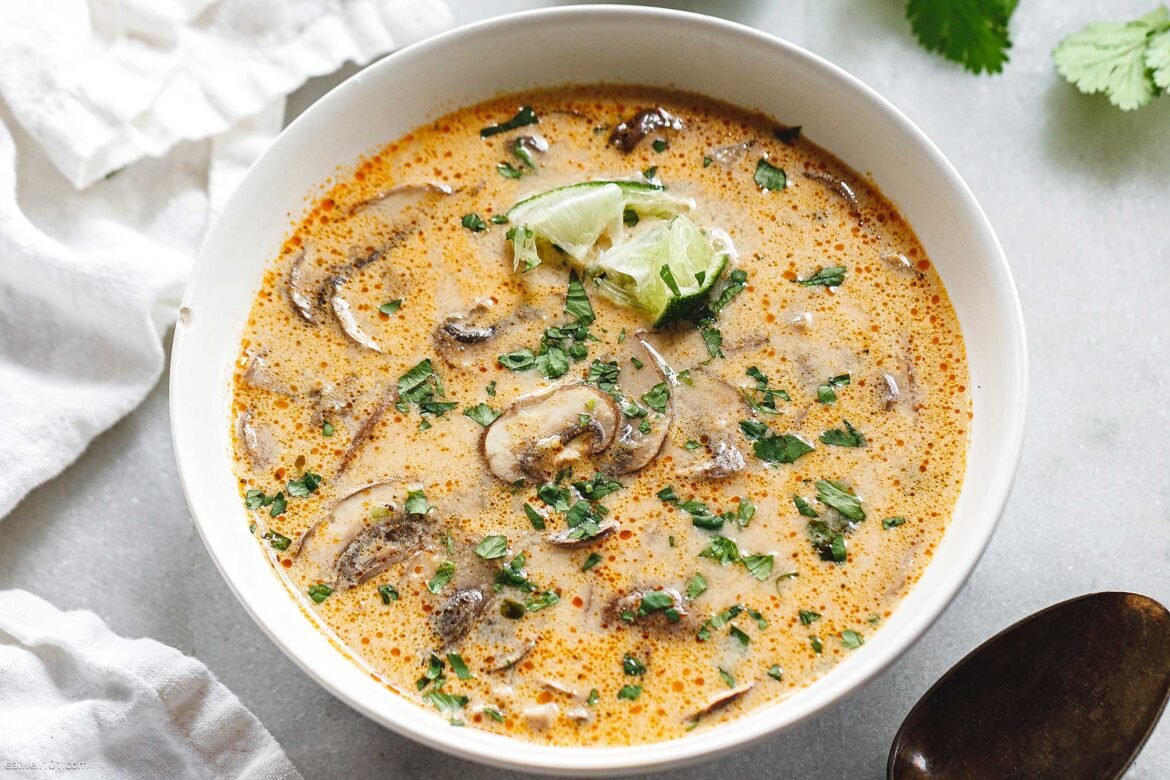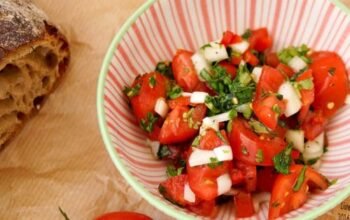Thai cuisine is known for its balance of intense flavors: spicy, sweet, sour, and savory. One of the dishes that best represents this harmony is Thai Coconut Broth . Aromatic, comforting, and incredibly flavorful, this broth combines typical Southeast Asian ingredients like lemongrass, ginger, coconut milk, and red curry , creating a versatile base that can be served plain or accompanied by vegetables, seafood, or chicken.
In this recipe, we’ll teach you how to make a Thai coconut broth in about 800 words, with detailed explanations, ingredient tips, and variations so you can customize it to your taste.
Ingredients
- 1 tablespoon coconut oil (or vegetable oil)
- 1 stalk of lemongrass , cut into pieces and lightly crushed
- 1 piece of fresh ginger (about 2 inches), thinly sliced
- 2 cloves of garlic, crushed or chopped
- 2 tablespoons Thai red curry paste
- 4 cups (1 liter) vegetable broth or chicken broth
- 400 ml of whole coconut milk (prefer the creamier one)
- 2 tablespoons fish sauce (nam pla) or soy sauce for vegetarian version
- 1 tablespoon lemon or lime juice
- 1 teaspoon brown sugar (optional)
- Finger pepper or red pepper (to taste)
- Chopped fresh cilantro, to finish
- Lemon or lime slices, to serve
Preparation Mode
1. Sauté the aromatics
In a medium saucepan, heat the coconut oil over medium heat. Add the lemongrass, ginger, and garlic. Sauté for 2 to 3 minutes, until the ingredients release their aromas. This step is essential for creating the aromatic base of the broth.
2. Add the curry paste
Add the red curry paste to the pan. Stir well for another 1 to 2 minutes. The paste will “fry” in the oil and blend with the spices, intensifying its flavor. This is a classic technique in Thai cuisine to activate the spices in the curry paste.
3. Add the broth
Pour in the vegetable or chicken broth. Stir well to dissolve the curry paste and ingredients. Simmer over medium heat for about 10 minutes. This will allow the broth to absorb all the flavors of the aromatic ingredients.
4. Add the coconut milk
Reduce the heat and add the coconut milk. Stir gently and let the broth simmer for another 5 to 7 minutes. Avoid boiling after adding the coconut milk, as this may curdle or alter the creamy texture.
5. Finish the flavor
Add the fish sauce, lime juice, and brown sugar (if using). Adjust the seasoning to taste: more lime for acidity, more fish sauce for saltiness, or more sugar for a milder curry. If you prefer a spicier kick, add thinly sliced chili peppers.
6. Serve in style
Remove the large pieces of lemongrass and ginger before serving. Serve the broth hot, garnished with chopped fresh cilantro and a slice of lemon or lime. It can be served plain as a starter or accompanied by rice, rice noodles, tofu, shredded chicken, or shrimp.
Side Dish Suggestions
Thai Coconut Broth is incredibly versatile. Here are some ideas to spice up the recipe:
- With chicken: Add strips of already cooked or sautéed chicken breast to the broth before the coconut milk.
- With shrimp: Add the shrimp in the last 5 minutes of cooking to soften them.
- Vegetarian version: Replace fish sauce with soy sauce and add fresh mushrooms, tofu, and bean sprouts.
- With rice noodles: Cook the noodles separately and serve with the broth on top. A complete and balanced meal.
Important Tips
- Lemongrass: If you can’t find fresh lemongrass, use 1 teaspoon of dried lemongrass, although the flavor won’t be as intense.
- Coconut milk: Use full-fat, creamy coconut milk, preferably canned. Avoid sweetened or highly diluted versions.
- Curry paste: Start with 2 tablespoons, but adjust to your preference. Some brands are spicier than others.
- Fish sauce: It’s salty and has a strong aroma, but it’s essential for the typical Thai flavor. Use sparingly.
A Broth that Embraces
Thai Coconut Broth is more than a recipe: it’s a sensory experience. The aroma of lemongrass, the slight spice of curry, and the creaminess of coconut milk make this broth a hug in food form. Whether to warm up a cold night or impress with an exotic dinner, it brings the flavor of Thailand to your table with simplicity and plenty of flavor.



